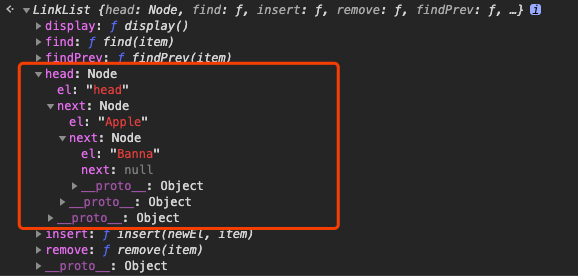前端说的栈、队列,它们都是列表的一种,底层的数据结构都是数组。
但是数组并不总是最佳的数据结构,索引引入链表结构:
链表(LinkedList)
介绍
链表的出现是为了解决数组增删的操作,在js中,虽然存在如下方法:
- 尾部添加
push - 尾部删除
pop - 头部添加
unshift - 头部删除
shift - 任意位置添加删除
splice
但是与其他语言相比,效率会比较低,所以考虑使用链表(Linked-list)来替换它,链表几乎可以在任何可以使用一位数组的情况中。
链表包含:
- 单向链表
- 双向链表
- 单向循环列表
- 双向循环列表
定义
链表是一组节点组成的集合,每个节点都使用一个对象的引用来指向它的后一个节点。指向另一个节点的引用称作为链。
其中,data保存数据,next保存着下一个链表的引用,链表的尾元素指向null,表示结束位置。
由于链表的起始点确定比较麻烦,因此在链表的最前面添加一个特殊的节点,成为头节点,表示链表的头部,如:
用我们常见的数据结构,大致是这样:
单向链表
设计链表包含两个类,一个是 Node 类用来表示节点,另一个是 LinkList 类提供增删等操作。
Node类
1
2
3
4function Node(el) {
this.el = el // 当前节点元素
this.next = null // 下一个节点的链接
}LinkList类
1
2
3
4
5
6
7
8
9function LinkList() {
this.head = new Node('head') // 头结点
this.find = find // 查找结点
this.findPrev = findPrev // 查找前一个结点
this.insertAfter = insertAfter // 在某个节点后插入节点(结合find)
this.insertBefore = insertBefore // 在某个节点后插入节点(结合findPrev)
this.remove = remove // 删除结点(结合findPrev)
this.display = display // 显示链表
}
下面挨个实现这些方法:
find 查找节点
1 | function find(el) { |
findPrev 查找前一个结点
1 | function findPrev(el) { |
insertAfter 在某个节点后插入节点
1 | function insertAfter(newEl, el) { |
insertBefore 在某个节点前插入节点
1 | function insertBefore(newEl, el) { |
remove 删除节点
1 | function remove(el) { |
display 显示链表
1 | function display() { |
全部代码如下:1
2
3
4
5
6
7
8
9
10
11
12
13
14
15
16
17
18
19
20
21
22
23
24
25
26
27
28
29
30
31
32
33
34
35
36
37
38
39
40
41
42
43
44
45
46
47
48
49
50
51
52
53
54
55
56
57
58
59
60
61
62
63
64
65function Node(el) {
this.el = el // 当前节点元素
this.next = null // 下一个节点的链接
}
function LinkList() {
this.head = new Node('head') // 头结点
this.find = find // 查找结点
this.findPrev = findPrev // 查找前一个结点
this.insertAfter = insertAfter // 在某个节点后插入节点(结合find)
this.insertBefore = insertBefore // 在某个节点后插入节点(结合findPrev)
this.remove = remove // 删除结点(结合findPrev)
this.display = display // 显示链表
}
// 查找节点
function find(el) {
var curNode = this.head // 从链表头部开始扫描
while(curNode.el !== el) {
curNode = curNode.next
}
return curNode
}
// 查找上一个节点
function findPrev(el) {
var prevNode = this.head // 从链表头部开始扫描
while(prevNode.next !== null && prevNode.next.el !== el) {
prevNode = prevNode.next
}
return prevNode
}
// 在某个节点后插入新节点
function insertAfter(newEl, el) {
var newNode = new Node(newEl)
var curNode = this.find(el)
newNode.next = curNode.next
curNode.next = newNode
}
// 在某个节点前插入新节点
function insertBefore(newEl, el) {
var newNode = new Node(newEl)
var prevNode = this.findPrev(el)
newNode.next = prevNode.next
prevNode.next = newNode
}
// 删除节点
function remove(el) {
var prevNode = this.findPrev(el)
if (prevNode !== null) {
prevNode.next = prevNode.next.next
}
}
// 显示链表
function display() {
var curNode = this.head // 从链表头部开始扫描
while(curNode !== null) {
console.log(curNode)
curNode = curNode.next
}
}
测试:1
2
3
4
5
6
7
8
9
10
11
12
13
14
15
16
17
18
19
20
21
22
23
24
25
26
27
28
29
30
31
32
33
34
35
36
37
38
39
40
41
42
43
44
45
46
47
48
49
50
51
52
53
54
55
56
57
58
59
60
61
62
63
64
65
66
67
68
69
70
71
72
73
74
75
76
77
78
79
80
81
82
83
84
85
86
87
88
89
90
91
92
93
94
95
96
97
98
99var nums = new LinkList()
// nums:
/* {
...,
head: {
el: 'head',
next: null
},
...
} */
nums.insertAfter('1', 'head') // 在head头节点之后插入节点1
// nums:
/* {
...,
head: {
el: 'head',
next: {
el: "1",
next: null
}
},
...
} */
nums.insertBefore('2', '1') // 在节点1之前插入节点2
// nums:
/* {
...,
head: {
el: 'head',
next: {
el: "2",
next: {
el: "1",
next: null
}
}
},
...
} */
nums.find('2') // 查找节点2
/* {
el: "2",
next: {
el: "1",
next: null
}
} */
nums.find('1') // 查找节点1
/* {
el: "1",
next: null
} */
nums.findPrev('1') // 查找节点1上一个节点(等同于find('2'))
/* {
el: "2",
next: {
el: "1",
next: null
}
} */
nums.remove('1') // 删除节点1
// nums:
/* {
...,
head: {
el: 'head',
next: {
el: "2",
next: null
}
},
...
} */
nums.display()
/* {
...,
head: {
el: 'head',
next: {
el: "2",
next: null
}
},
...
} */
/* {
...,
head: {
el: '2',
next: null
},
...
} */
双向链表
要实现双向链表,除了 next 外,还需要一个 previous 属性:1
2
3
4
5function Node(el) {
this.el = el
this.next = null
this.previous = null
}
完整代码如下:1
2
3
4
5
6
7
8
9
10
11
12
13
14
15
16
17
18
19
20
21
22
23
24
25
26
27
28
29
30
31
32
33
34
35
36
37
38
39
40
41
42
43
44
45
46
47
48
49
50
51
52
53
54
55
56
57
58
59
60
61
62
63
64
65
66
67
68
69
70
71
72
73
74
75function Node(el) {
this.el = el
this.next = null
this.previous = null
}
function LinkList() {
this.head = new Node('head') // 头结点
this.find = find // 查找结点
this.findLast = findLast // 查找最后一个结点
this.insert = insert // 在某个节点后插入节点
this.remove = remove // 删除结点
this.display = display // 显示链表
this.displayReverse = displayReverse // 反向显示链表
}
// 查找结点
function find(el) {
var curNode = this.head // 从链表头部开始扫描
while(curNode.el !== el) {
curNode = curNode.next
}
return curNode
}
// 查找最后一个结点
function findLast() {
var curNode = this.head // 从链表头部开始扫描
while(curNode.next !== null) {
curNode = curNode.next
}
return curNode
}
// 在某个节点后插入节点
function insert(newEl, el) {
var newNode = new Node(newEl)
var curNode = this.find(el)
newNode.next = curNode.next
newNode.previous = curNode
curNode.next = newNode
}
// 删除结点
function remove(el) {
var curNode = this.find(el)
if (curNode.next !== null) {
curNode.previous.next = curNode.next
curNode.next.previous = curNode.previous
curNode.next = null
curNode.previous = null
} else {
curNode.previous.next = null
}
}
// 显示链表
function display() {
var curNode = this.head
// 注意while中为curNode,而非curNode.next,curNode.next会漏掉尾部
while(curNode !== null) {
console.log(curNode)
curNode = curNode.next
}
}
// 反向显示链表
function displayReverse() {
var curNode = this.findLast()
// 注意while中为curNode,而非curNode.previous,curNode.previous会溜掉头部
while(curNode !== null) {
console.log(curNode)
curNode = curNode.previous
}
}
单向循环链表
单向循环链表,尾结点的next指向头节点,即:
循环链表判断最后一个节点的条件不再是“后继是否为空”,而是“后继是否为头节点”。
双向循环链表
单向循环列表链表 + 双向链表 组合情况